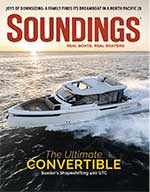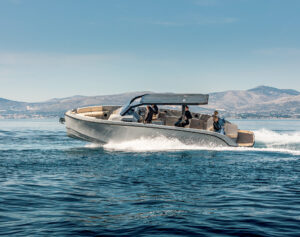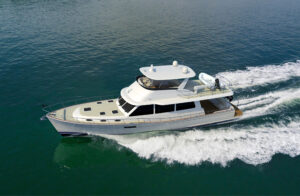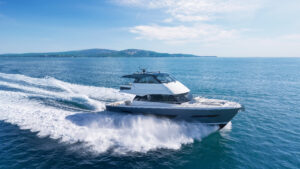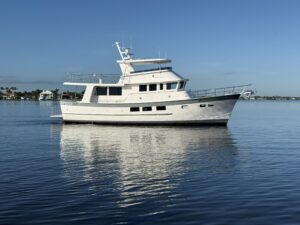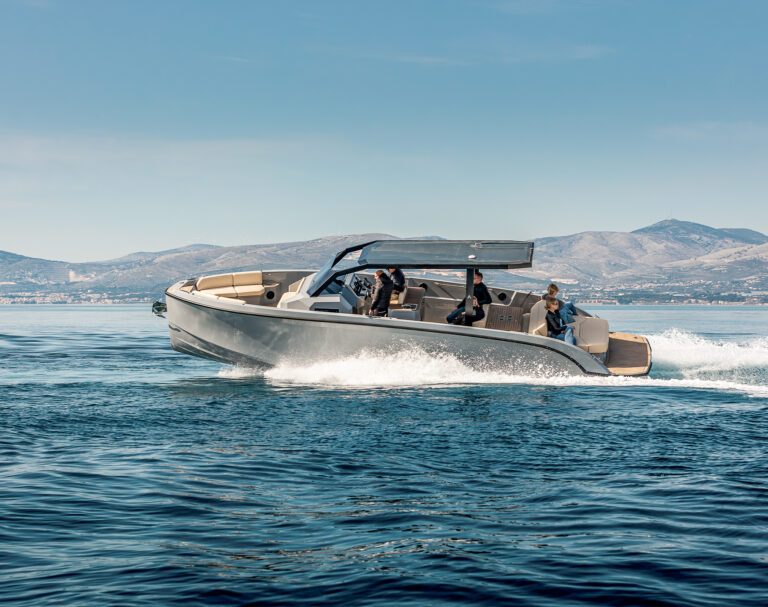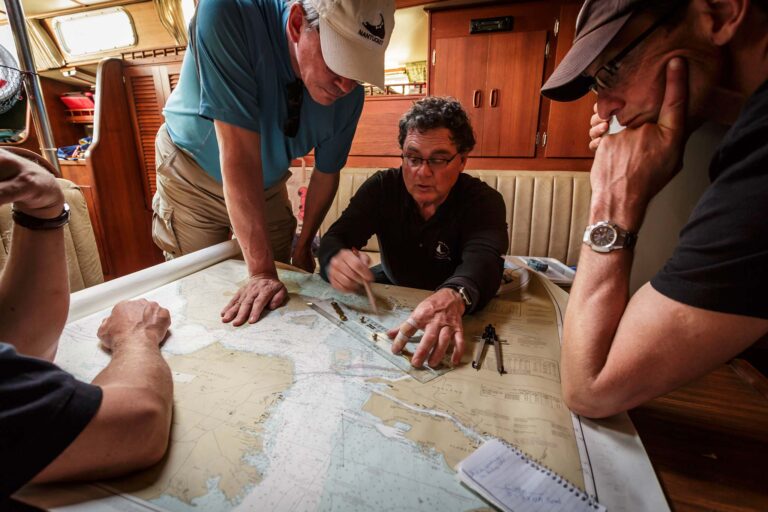Wind from the west, honking hard. Current in the opposite direction, running fast. The track is torn up with potholes big enough to swallow an elephant, but the boat — all 2 tons of it — is flying. Up, down, crash! Up, down, splash! Icy water trickling down the collar, seeping through the bottom of the leaky, old foulies. But everyone has a ball.Sandwiches and adult beverages are handed up from the cabin, and the helmsman whistles “Yo, ho, ho and a bottle of rum.” If we can take it, the Nordic Folkboat surely will. It’s a descendant of the sturdy Viking ships, a wind’s bride that knows how to handle Erasmus’ moods.

This spring, the Nordic Folkboat celebrates the 70th anniversary of hull No. 1’s launch on April 23, 1942, dodging ice floes in the harbor of Gothenburg, Sweden. More than 4,000 of these boats still exist, the majority of them built from biomass.
At a time when sail-powered craft manage a top speed of 55 knots and nearly 1,000 nautical miles in 24 hours, the Folkboat is a charming — and charmed — anachronism. It’s old and small. It’s heavy and under-canvased. And it’s under-fast, compared to the performance of modern sportboats. The spars are spruce. The spinnaker? What spinnaker? And consider the looks. The Folkboat’s skin is wrinkled, either by genuine clinker planks of larch or Douglas fir or by fiberglass that mimics the real deal.
The keel is long, but the waterline is short. The stern is flat, the cabin tiny, and the head most often is just a bucket. Privacy is non-existent and the only way to add living space is to string a tent over the cockpit.
Yet the boat still strikes a chord in many, not just with seakindliness and a stubborn ability to keep a straight line when everyone else is reefed down or running for cover, but with its defiant aesthetic and pleasant proportions, which set it apart from the floating fortresses of mass production. Length to beam, freeboard to cabin top, overhang to waterline, it looks right, feels right and blends well.
Of course, there has been modest modernization, including Dacron sails and fiberglass hulls that race against wood without handicap. But, by and large, the boat has maintained its straightforward simplicity, affordability and predictable, tempered manners.
“Easy handling and good performance in all weather conditions,” raves Carl-Ove Thor, a lifelong Folkboat addict from Denmark and the curator of a special anniversary exhibit at Valdemars Slot in Svendborg, Denmark. “It’s uncomplicated, and I can sail it in and out of port. Even without reefing it’s safe and comfortable.”
It can be single-handed and, if something breaks, it doesn’t kill the kitty to replace or repair it.
Unusual genesis
As the name suggests, the premise was egalitarian and the story of its origin has a democratic bent. In 1941, as war raged, a design contest was held across Scandinavia for a new boat that was affordable to build, easy to sail with the family and fun to race. Of 58 entries, four won awards, but no winner was crowned.
Then there was Sven Salén, a Swedish shipping magnate who won Olympic bronze in 1936 in the Six Meter. He promoted the contest and invited a young naval architect named Tord Sundén to amalgamate the awarded entries into one set of plans, which were published unsigned before the first boat was laid up at the Arendals yard in Gothenburg in October 1941. The boat was launched April 23 the following year, but the war had begun to affect the economy in Sweden, which remained neutral.
Cotton for the sails and iron for the keels were difficult to source, but again Seldén rode to the rescue, financing the construction of the first batch of boats and helping to establish the class. Sundén later claimed ownership of the Folkboat’s design, but was rebuffed by the courts, eventually settling the matter with the Scandinavian Sailing Association. In the 1960s he designed the slightly larger, but also handsome and seaworthy International Folkboat.
After the war, the Nordic Folkboat proliferated through artisan builders such as Boerresen, Brandt-Moeller, Lind, Ove Kaae and countless do-it-yourselfers. Sweden, Denmark and Germany remain the largest Folkboat cultures, but the boats also found a following elsewhere, including the U.K., Holland and North America, where Scandinavian immigrants started fleets. It also inspired countless adventurous voyages, such as the one by Australian grandmother Ann Gash, who sailed Ilimo around the world, or Blondie Hasler, whose Folkboat-inspired, junk-rigged Jester became an icon of the Single-handed Transatlantic Race.
Folkboats in San Francisco
With its stout constitution, small sail area and long keel, the boat is ideal for the wild waters and stiff winds of San Francisco Bay. Not surprisingly, the next America’s Cup venue is home to the largest and most active Folkboat fleet outside Europe. Wednesday Night races, which commenced in 1961, remained popular in this fleet, which was constituted in 1957.
After the heyday of the 1960s, the popularity of Folkboats declined, though it never died. With 80 members, about half of them active sailors, the fleet has rebounded and enjoys the support of veterans, who pitch in by helping out on the race deck or by lending boats for the International Cup, which attracts crews from Europe and has been held every other year since the late 1960s.
“Our biggest asset is the group of people this boat attracts,” says fleet vice president Hillary Andersen, a second-generation Folkboater, whose husband, Fred, is a shipwright. The Andersens are campaigning one of the fleet’s last wooden boats, a jewel from Denmark with a varnished hull.
A challenge for the sustained growth of the fleet is the dearth of new boats, which are no longer built locally. Sailors from Europe who participate in the International Cup ship boats to California and sell them to fleet members who are looking to upgrade or to newcomers who want to get into the game.
Another challenge is the marina upgrade that is about to happen for the America’s Cup. It threatens to curtail the number of berths at the docks across from the St. Francis and Golden Gate yacht clubs that are occupied by Folkboats and other classic fleets, such as Knarrs and International One Designs.
“They want to make more money with fewer but larger slips, which would eliminate or drastically reduce the docking for boats in the 25- to 30-foot range,” Andersen says. “It would be detrimental if we lost our base in the city. It’s scary.”
It falls to fleet president Richard Keldsen to find allies in this struggle with the San Francisco Recreation and Parks Department. “We need to convince them that these boats have historic significance and need berths once the marina’s remodel is done,” Keldsen says.
It’s another big test, but the fleet is resilient. “You know, there’s this Folkboat spirit.”

Different places, different grooves
Although “frozen snot” — aka fiberglass — and racing dominate the scene in California, it’s a bit different in Europe. Sure, fiberglass boats are also popular there and they continue to be built in Estonia, although the company that markets them was sold and moved from Denmark to Germany.
“The Folkboat needs young sailors who get lured by traditional values,” says “Mr. Folkboat,” Erik Andreasen, who came up with the fiberglass hull for the Nordic Folkboat. It irked purists, but saved the class from the scrap heap.
Today an astonishing number of sailors continue to buy, restore and maintain wooden Folkboats, which they use for weekend sailing and cruising in the picturesque waters of the Baltic or the skerry islands along the Swedish coast.
Photographer Michael Müller, of Hamburg, is one of them. “If I had more money I’d get another Folkboat,” he says, “only a bit newer, but a woody for sure. What else is there to sail, really?”
Echoing Andersen, of the San Francisco fleet, Müller says he’s drawn to the boat because of the characters it attracts. They don’t need double-digit speeds, standing headroom and en-suite heads and prefer to sail outside the mainstream. “Like a rare classic car, a Folkboat stands out, but doesn’t make you look like a pretentious fool,” he says. “And that breeds company.”
Since April 23, 1942, much has changed, but the Folkboat remains true to its values and virtues. The essence of this boat is manifested by understatement and simplicity and a gentle but resolute personality that is framed by distinctive looks. And through all of it, the Nordic Folkboat remains a boat for the people while it still stands up to Erasmus’ tempestuous moods.
For more on this venerable sailboat, visit www.folkboats.com, www.folkboat.de, and www.sfbayfolkboats.org.

Dieter Loibner is Soundings’ sailing editor and the author of “The Folkboat Story.” signed copies are available for $30 (paperback) and $75 (first edition hardcover), plus shipping and handling. Send inquiries to sustainablesailing@gmail.
This article originally appeared in the April 2012 issue.

